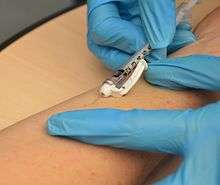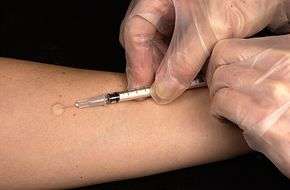Intradermal injection
Intradermal injection, often abbreviated ID, is a shallow or superficial injection of a substance into the dermis, which is located between the epidermis and the hypodermis. This route is relatively rare compared to injections into the subcutaneous tissue or muscle. Due to the more complex use, ID injections are not the preferred route of administration for injection and therefore used for certain therapies only, such as tuberculose tests and allergy tests. Specific benefits are a higher immune responses for vaccinations, immunology and novel cancer treatments and faster drug uptake[1], since for certain small and well soluble proteins or molecules, ID route of administration is associated with fast uptake systemically compared to subcutaneous injections, applied in novel closed loop insuline infusion systems. Additionally, the body's reaction to substances is more easily visible since it is closer to the surface.[2]


Injection sites
Common injection sites include the inner surface of the forearm and the upper back, under the shoulder blade.[2].
Equipment
Equipment include syringes calibrated in tenths and hundredths of a milliliter. The dosage given is usually less than 0.5 mL, less than given subcutaneously or intramuscularly. A 1⁄4-to-1⁄2-inch-long (6 to 13 mm) and 26 or 27 gauge thick needle is used.[2]
Mantoux Procedure
The traditional procedure of ID injection (Mantoux Procedure) involves injecting at angle of administration of 5 to 15 degrees angle, almost against the skin. With bevel (opening) side up, the needle is inserted about 1⁄8 inch (3 mm) with the entire bevel inside and injected while watching for a small wheal or blister to appear. When the needle is removed, it is immediately placed in the sharps container. The patient is instructed to avoid touching the injection site, to not apply a bandaid, and to return within 48 hours to have their TB test read. All soiled supplies are disposed of in a biohazard container, and the procedure is documented, making note of patient identifiers, injection site, NDC or LOT number, and expiration date on the vial.

Intradermic needles
Traditionally hypodermic needles are used for intradermal injections, instead of intradermic needles. Various microneedle technology researchers worldwide develop new devices and therapies to overcome typical usability issues associated with traditional Mantoux Procedure. Most intradermic needles require a change in injection technique or instruction to use, for example a perpendicular intradermal injection.
See also
- Subcutaneous injection
- Intramuscular injection
- Intravenous injection
References
- Rini CJ, McVey E, Sutter D, Keith S, Kurth HJ, Nosek L, Kapitza C, Rebrin K, Hirsch L, Pettis RJ (August 2015). "Intradermal insulin infusion achieves faster insulin action than subcutaneous infusion for 3-day wear". Drug Delivery and Translational Research. 5 (4): 332–45. doi:10.1007/s13346-015-0239-x. PMC 4529466. PMID 26037035.
- Taylor CR, Lillis C, LeMone P, Lynn P (2011). Fundamentals of nursing : the art and science of nursing care (7th ed.). Philadelphia: Wolters Kluwer Health/Lippincott Williams & Wilkins. p. 749, 788. ISBN 978-0-7817-9383-4.